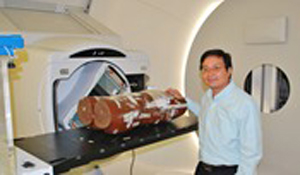Program Information
Comparison of Head Scatters in Flattening-Filter-Free and Flattened Photon Beams
Y Chen1*, R Shih2, M Afghan2, A Gopal2, H Chen2, (1) Columbia University, New York, NY, (2) New York Presbyterian Hospital, New York, NY
SU-E-T-1 Sunday 3:00PM - 6:00PM Room: Exhibit HallPurpose: To decouple and quantify scatter contributions in air and in phantom for flattening-filter-free (FFF) photon beams in comparison with those for flattened beams from a medical linac in radiotherapy.
Methods: The 7 UF FFF beam on a Siemens Artiste linac shows equivalent depth dose distribution as the 6 MV flat beam. An ionization chamber was used to measure doses along central axis in air (with a 3 cm diameter buildup cap) and in phantom (SSD = 100 cm and depth = 1.5 cm) for both beams in a range of field size, yielding head scatter factors (Sc) and output factors (Scp). A third-order polynomial function was used to fit the data within the fields of 3x3 to 12x12 cm² for each Sc or Scp distribution. An extrapolation of the fitted function to 0x0 field yielded the dose component due to primary radiation. Scatter components for different field sizes can be derived by subtracting this primary component from measured total doses.
Results: A primary FFF beam produces only 5% scatters in 10x10 cm² field through the linac head while 43% scatters are produced by a flat primary beam, resulting in a reduction of scatter contributions by a factor of 6 in the measured doses in air. Comparable scatter contributions (~10% in 10x10 field) produced in the phantom at the same depth were observed for both primary beams as expected. Overall, the significantly reduced head scatter for the FFF beam leads to a total scatter reduction of 60% in phantom at 1.5 cm depth (14% and 34% scatter contributions in 10x10 field for the FFF and flat beams, respectively).
Conclusion: Our method works well in decoupling scatter components from measured total doses. The significant reduction of head scatters for FFF beams would provide dosimetric benefits to patients with reduced shallow-dose.
Funding Support, Disclosures, and Conflict of Interest: This work is supported in part by a Siemens research fund.
Contact Email:


